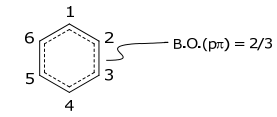1.7: Hückel Theory 2 (Eigenvalues)
- Page ID
- 221675
\( \newcommand{\vecs}[1]{\overset { \scriptstyle \rightharpoonup} {\mathbf{#1}} } \)
\( \newcommand{\vecd}[1]{\overset{-\!-\!\rightharpoonup}{\vphantom{a}\smash {#1}}} \)
\( \newcommand{\id}{\mathrm{id}}\) \( \newcommand{\Span}{\mathrm{span}}\)
( \newcommand{\kernel}{\mathrm{null}\,}\) \( \newcommand{\range}{\mathrm{range}\,}\)
\( \newcommand{\RealPart}{\mathrm{Re}}\) \( \newcommand{\ImaginaryPart}{\mathrm{Im}}\)
\( \newcommand{\Argument}{\mathrm{Arg}}\) \( \newcommand{\norm}[1]{\| #1 \|}\)
\( \newcommand{\inner}[2]{\langle #1, #2 \rangle}\)
\( \newcommand{\Span}{\mathrm{span}}\)
\( \newcommand{\id}{\mathrm{id}}\)
\( \newcommand{\Span}{\mathrm{span}}\)
\( \newcommand{\kernel}{\mathrm{null}\,}\)
\( \newcommand{\range}{\mathrm{range}\,}\)
\( \newcommand{\RealPart}{\mathrm{Re}}\)
\( \newcommand{\ImaginaryPart}{\mathrm{Im}}\)
\( \newcommand{\Argument}{\mathrm{Arg}}\)
\( \newcommand{\norm}[1]{\| #1 \|}\)
\( \newcommand{\inner}[2]{\langle #1, #2 \rangle}\)
\( \newcommand{\Span}{\mathrm{span}}\) \( \newcommand{\AA}{\unicode[.8,0]{x212B}}\)
\( \newcommand{\vectorA}[1]{\vec{#1}} % arrow\)
\( \newcommand{\vectorAt}[1]{\vec{\text{#1}}} % arrow\)
\( \newcommand{\vectorB}[1]{\overset { \scriptstyle \rightharpoonup} {\mathbf{#1}} } \)
\( \newcommand{\vectorC}[1]{\textbf{#1}} \)
\( \newcommand{\vectorD}[1]{\overrightarrow{#1}} \)
\( \newcommand{\vectorDt}[1]{\overrightarrow{\text{#1}}} \)
\( \newcommand{\vectE}[1]{\overset{-\!-\!\rightharpoonup}{\vphantom{a}\smash{\mathbf {#1}}}} \)
\( \newcommand{\vecs}[1]{\overset { \scriptstyle \rightharpoonup} {\mathbf{#1}} } \)
\( \newcommand{\vecd}[1]{\overset{-\!-\!\rightharpoonup}{\vphantom{a}\smash {#1}}} \)
\(\newcommand{\avec}{\mathbf a}\) \(\newcommand{\bvec}{\mathbf b}\) \(\newcommand{\cvec}{\mathbf c}\) \(\newcommand{\dvec}{\mathbf d}\) \(\newcommand{\dtil}{\widetilde{\mathbf d}}\) \(\newcommand{\evec}{\mathbf e}\) \(\newcommand{\fvec}{\mathbf f}\) \(\newcommand{\nvec}{\mathbf n}\) \(\newcommand{\pvec}{\mathbf p}\) \(\newcommand{\qvec}{\mathbf q}\) \(\newcommand{\svec}{\mathbf s}\) \(\newcommand{\tvec}{\mathbf t}\) \(\newcommand{\uvec}{\mathbf u}\) \(\newcommand{\vvec}{\mathbf v}\) \(\newcommand{\wvec}{\mathbf w}\) \(\newcommand{\xvec}{\mathbf x}\) \(\newcommand{\yvec}{\mathbf y}\) \(\newcommand{\zvec}{\mathbf z}\) \(\newcommand{\rvec}{\mathbf r}\) \(\newcommand{\mvec}{\mathbf m}\) \(\newcommand{\zerovec}{\mathbf 0}\) \(\newcommand{\onevec}{\mathbf 1}\) \(\newcommand{\real}{\mathbb R}\) \(\newcommand{\twovec}[2]{\left[\begin{array}{r}#1 \\ #2 \end{array}\right]}\) \(\newcommand{\ctwovec}[2]{\left[\begin{array}{c}#1 \\ #2 \end{array}\right]}\) \(\newcommand{\threevec}[3]{\left[\begin{array}{r}#1 \\ #2 \\ #3 \end{array}\right]}\) \(\newcommand{\cthreevec}[3]{\left[\begin{array}{c}#1 \\ #2 \\ #3 \end{array}\right]}\) \(\newcommand{\fourvec}[4]{\left[\begin{array}{r}#1 \\ #2 \\ #3 \\ #4 \end{array}\right]}\) \(\newcommand{\cfourvec}[4]{\left[\begin{array}{c}#1 \\ #2 \\ #3 \\ #4 \end{array}\right]}\) \(\newcommand{\fivevec}[5]{\left[\begin{array}{r}#1 \\ #2 \\ #3 \\ #4 \\ #5 \\ \end{array}\right]}\) \(\newcommand{\cfivevec}[5]{\left[\begin{array}{c}#1 \\ #2 \\ #3 \\ #4 \\ #5 \\ \end{array}\right]}\) \(\newcommand{\mattwo}[4]{\left[\begin{array}{rr}#1 \amp #2 \\ #3 \amp #4 \\ \end{array}\right]}\) \(\newcommand{\laspan}[1]{\text{Span}\{#1\}}\) \(\newcommand{\bcal}{\cal B}\) \(\newcommand{\ccal}{\cal C}\) \(\newcommand{\scal}{\cal S}\) \(\newcommand{\wcal}{\cal W}\) \(\newcommand{\ecal}{\cal E}\) \(\newcommand{\coords}[2]{\left\{#1\right\}_{#2}}\) \(\newcommand{\gray}[1]{\color{gray}{#1}}\) \(\newcommand{\lgray}[1]{\color{lightgray}{#1}}\) \(\newcommand{\rank}{\operatorname{rank}}\) \(\newcommand{\row}{\text{Row}}\) \(\newcommand{\col}{\text{Col}}\) \(\renewcommand{\row}{\text{Row}}\) \(\newcommand{\nul}{\text{Nul}}\) \(\newcommand{\var}{\text{Var}}\) \(\newcommand{\corr}{\text{corr}}\) \(\newcommand{\len}[1]{\left|#1\right|}\) \(\newcommand{\bbar}{\overline{\bvec}}\) \(\newcommand{\bhat}{\widehat{\bvec}}\) \(\newcommand{\bperp}{\bvec^\perp}\) \(\newcommand{\xhat}{\widehat{\xvec}}\) \(\newcommand{\vhat}{\widehat{\vvec}}\) \(\newcommand{\uhat}{\widehat{\uvec}}\) \(\newcommand{\what}{\widehat{\wvec}}\) \(\newcommand{\Sighat}{\widehat{\Sigma}}\) \(\newcommand{\lt}{<}\) \(\newcommand{\gt}{>}\) \(\newcommand{\amp}{&}\) \(\definecolor{fillinmathshade}{gray}{0.9}\)The energies (eigenvalues) may be determined by using the Hückel approximation.
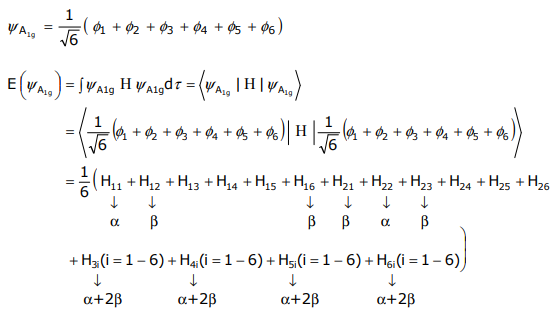
\[ E \left( \psi_{B_{2g}} \right) = \dfrac{1}{6}(6)( \alpha - 2\beta ) = \alpha - 2\beta \]
The energies of the remaining LCAO’s are:
\[ E \left( \psi_{E_{1g}}^a \right) = \left( \psi_{E_{1g}}^b \right) = \alpha + \beta \]
\[ E \left( \psi_{E_{2u}}^a \right) = \left( \psi_{E_{2u}}^b \right) = \alpha - \beta \]
Note the energies of the E orbitals are degenerate. Constructing the energy level diagram, we set α = 0 and β as the energy parameter (a negative quantity, so an MO whose energy is positive in units of β has an absolute energy that is negative),
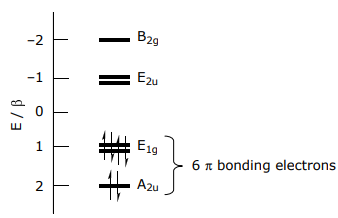
The energy of benzene based on the Hückel approximation is
\[ E_{total} = 2(2\beta) + 4(\beta) = 8\beta \]
What is the delocalization energy (i.e. π resonance energy)?
To determine this, we consider cyclohexatriene, which is a six-membered cyclic ring with 3 localized π bonds; in other terms, cyclohexatriene is the product of three condensed ethylene molecules. For ethylene,

Following the procedures outlined above, we find,
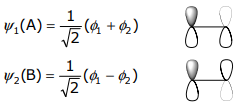
\begin{aligned}
&\mathrm{E}\left(\psi_{1}\right)=\left\langle\frac{1}{\sqrt{2}}\left(\phi_{1}+\phi_{2}\right)|\mathrm{H}| \frac{1}{\sqrt{2}}\left(\phi_{1}+\phi_{2}\right)\right\rangle=\frac{1}{2}(2 \alpha+2 \beta)=\beta \\
&\mathrm{E}\left(\psi_{2}\right)=\left\langle\frac{1}{\sqrt{2}}\left(\phi_{1}-\phi_{2}\right)|\mathrm{H}| \frac{1}{\sqrt{2}}\left(\phi_{1}-\phi_{2}\right)\right\rangle=\frac{1}{2}(2 \alpha-2 \beta)=-\beta
\end{aligned}
The above was determined in the C2 point group. Correlating to D2h point group gives A in C2 → B1u in D2h and B in C2 → B2g in D2h:
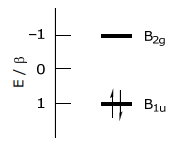
The Hückel energy of ethylene is,
\[ E_{total} = 2(\beta) = 2\beta \]
Therefore, the energy of cyclohexatriene is 3(2β) = 6β. The resonance energy is therefore,

The bond order is given by,

Consider the B.O. between the C1 and C2 carbons of benzene
\[ [ \psi_{1}(A_{2u})] = 2( \dfrac{1}{ \sqrt{6}} )( \dfrac{1}{ \sqrt{6}}) = \dfrac{1}{3} \]
\[ [ \psi_{3}(E_{1g}^a)] = 2( \dfrac{1}{ \sqrt{12}} )( \dfrac{1}{ \sqrt{12}}) = \dfrac{1}{3} \]
\[ [ \psi_{4}(E_{1g}^b)] = \dfrac{1}{2}(0)( \dfrac{1}{2} ) = \dfrac{0}{ \dfrac{2}{3} } \]
